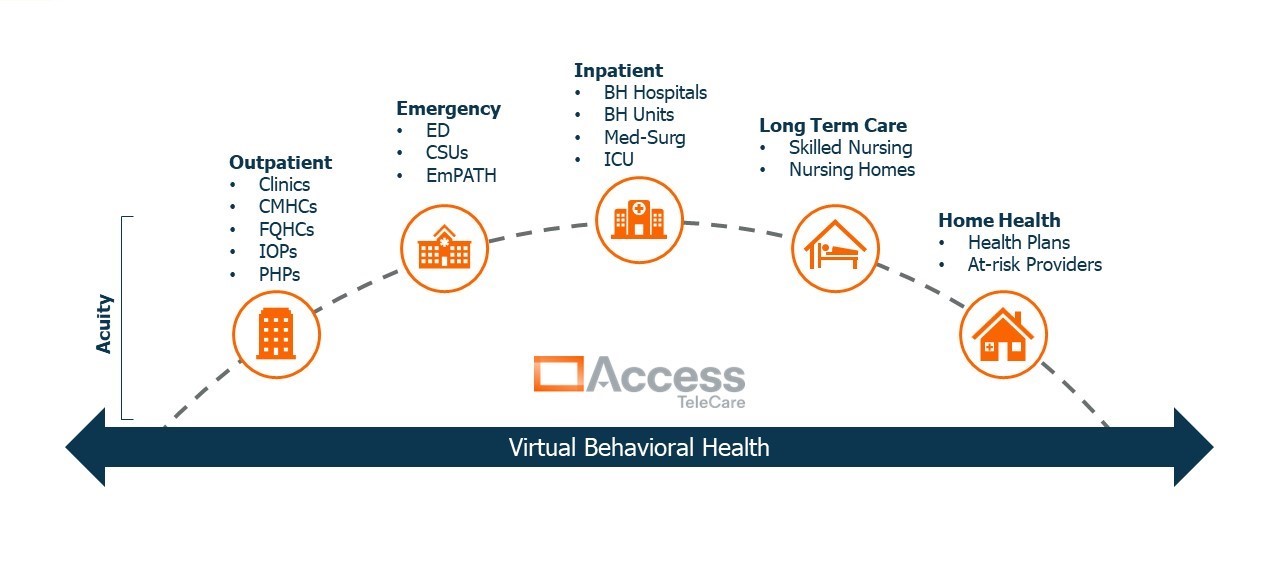What is telePsychiatry?
TelePsychiatry leverages telemedicine to provide behavioral health coverage for hospital emergency departments as well as consultation-liaison psychiatry inpatient consultations anywhere in the hospital.

Comprehensive Behavioral Health Care Through Telemedicine
TelePsychiatry is the diagnosis and treatment of mental health patients by a remote clinician using telecommunications technology like videoconferencing. It makes it possible for a psychiatrist and patient to be in separate rooms, cities, states, or even countries and still be connected face-to-face.
When a patient with mental health or substance abuse issue arrives at the ED, they are triaged similar to any other illness. Once any medical issues are established or eliminated, the patient is typically isolated and monitored closely. Hospitals request a behavioral health consult, and the patient is seen by the remote psychiatrist. Treatment options are discussed with the patient, the patient’s family, and onsite staff.
How does telePsychiatry work in a hospital?
The use cases for telePsychiatry are well-established in hospitals.
In the emergency room, remote specialists can “beam in” to consult with the patient and onsite staff for patients with mental health or substance abuse issues. TelePsychiatry can also be used with admitted patients when mental status changes occur due to anxiety or stress.
Using Telemedicine to Overcome Behavioral Health Hospital Challenges
Access TeleCare helps behavioral health hospitals care for more patients locally, reducing transfers and improving care with timely access to behavioral health specialists.
Accelerate Emergency Throughput With Telemedicine
With Access TeleCare, hospitals have the ability to more quickly move patients through their emergency departments to the advantage of patients and emergency department care teams.
How do mental health and substance abuse patients impact the Emergency Department?
Medical emergency departments are not designed to handle large volumes of mentally ill patients. ED physicians are understandably uncomfortable determining the plan of care in a silo as the vast majority have not received in-depth behavioral health training. There are several ways an Emergency Department can be impacted:
Who We Serve
What is boarding?
Boarding is the term used to describe the wait time a mental health patient experiences after diagnosis but before inpatient treatment. On average, mental health patients can wait 8 to 34 hours for an inpatient bed. Just about every hospital or ED physician can tell you stories about much longer waits—100s of hours, even days. According to a recent poll, 70% of emergency physicians reported psychiatry patients being boarded in the ED on their last shift.
An inpatient bed is not a certainty, however. Inpatient psychiatric services have declined sharply, making post-discharge placement a very real challenge.
- There has been a 77.4% reduction in inpatient psychiatric capacity nationwide
- And $5 billion in additional state funding cuts between 2009-2012
How can emergency departments decrease suicides with telePsychiatry?
Suicide is currently the 10th leading cause of death in the U.S. and suicide rates have risen sharply over the years―increasing by more than 30% in most states. Because so many mental health patients present to the ED, we have a unique chance to screen these patients for suicide risk.
The Joint Commission reviewed its National Patient Safety Goal for suicide prevention, adjusting the requirements (NPSG 15.1.1) as of July 1, 2019. All hospitals participating in the Hospital Accreditation Program are now required to screen patients for suicidal ideation and conduct a risk assessment. Those patients identified and documented as moderate- or high-risk require a plan—mitigating the risk of suicide.
With telePsychiatry, these assessments could be done by a remote provider, freeing up clinicians and other staff for other patients.
The Benefits of telePsychiatry












